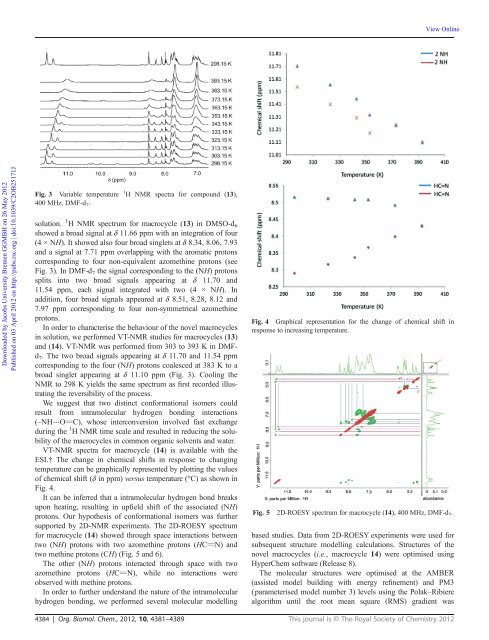The Development of Novel Antibiotics Using ... - Jacobs University
The Development of Novel Antibiotics Using ... - Jacobs University
The Development of Novel Antibiotics Using ... - Jacobs University
You also want an ePaper? Increase the reach of your titles
YUMPU automatically turns print PDFs into web optimized ePapers that Google loves.
View Online<br />
Downloaded by <strong>Jacobs</strong> <strong>University</strong> Bremen GGMBH on 26 May 2012<br />
Published on 03 April 2012 on http://pubs.rsc.org | doi:10.1039/C2OB25171J<br />
Fig. 3 Variable temperature 1 H NMR spectra for compound (13),<br />
400 MHz, DMF-d 7 .<br />
solution. 1 H NMR spectrum for macrocycle (13) in DMSO-d 6<br />
showed a broad signal at δ 11.66 ppm with an integration <strong>of</strong> four<br />
(4 × NH). It showed also four broad singlets at δ 8.34, 8.06, 7.93<br />
and a signal at 7.71 ppm overlapping with the aromatic protons<br />
corresponding to four non-equivalent azomethine protons (see<br />
Fig. 3). In DMF-d 7 the signal corresponding to the (NH) protons<br />
splits into two broad signals appearing at δ 11.70 and<br />
11.54 ppm, each signal integrated with two (4 × NH). In<br />
addition, four broad signals appeared at δ 8.51, 8.28, 8.12 and<br />
7.97 ppm corresponding to four non-symmetrical azomethine<br />
protons.<br />
In order to characterise the behaviour <strong>of</strong> the novel macrocycles<br />
in solution, we performed VT-NMR studies for macrocycles (13)<br />
and (14). VT-NMR was performed from 303 to 393 K in DMFd<br />
7 . <strong>The</strong> two broad signals appearing at δ 11.70 and 11.54 ppm<br />
corresponding to the four (NH) protons coalesced at 383 K to a<br />
broad singlet appearing at δ 11.10 ppm (Fig. 3). Cooling the<br />
NMR to 298 K yields the same spectrum as first recorded illustrating<br />
the reversibility <strong>of</strong> the process.<br />
We suggest that two distinct conformational isomers could<br />
result from intramolecular hydrogen bonding interactions<br />
(–NH⋯OvC), whose interconversion involved fast exchange<br />
during the 1 H NMR time scale and resulted in reducing the solubility<br />
<strong>of</strong> the macrocycles in common organic solvents and water.<br />
VT-NMR spectra for macrocycle (14) is available with the<br />
ESI.† <strong>The</strong> change in chemical shifts in response to changing<br />
temperature can be graphically represented by plotting the values<br />
<strong>of</strong> chemical shift (δ in ppm) versus temperature (°C) as shown in<br />
Fig. 4.<br />
It can be inferred that a intramolecular hydrogen bond breaks<br />
upon heating, resulting in upfield shift <strong>of</strong> the associated (NH)<br />
protons. Our hypothesis <strong>of</strong> conformational isomers was further<br />
supported by 2D-NMR experiments. <strong>The</strong> 2D-ROESY spectrum<br />
for macrocycle (14) showed through space interactions between<br />
two (NH) protons with two azomethine protons (HCvN) and<br />
two methine protons (CH) (Fig. 5 and 6).<br />
<strong>The</strong> other (NH) protons interacted through space with two<br />
azomethine protons (HCvN), while no interactions were<br />
observed with methine protons.<br />
In order to further understand the nature <strong>of</strong> the intramolecular<br />
hydrogen bonding, we performed several molecular modelling<br />
Fig. 4 Graphical representation for the change <strong>of</strong> chemical shift in<br />
response to increasing temperature.<br />
Fig. 5 2D-ROESY spectrum for macrocycle (14), 400 MHz, DMF-d 7 .<br />
based studies. Data from 2D-ROESY experiments were used for<br />
subsequent structure modelling calculations. Structures <strong>of</strong> the<br />
novel macrocycles (i.e., macrocycle 14) were optimised using<br />
HyperChem s<strong>of</strong>tware (Release 8).<br />
<strong>The</strong> molecular structures were optimised at the AMBER<br />
(assisted model building with energy refinement) and PM3<br />
(parameterised model number 3) levels using the Polak–Ribiere<br />
algorithm until the root mean square (RMS) gradient was<br />
4384 | Org. Biomol. Chem., 2012, 10, 4381–4389 This journal is © <strong>The</strong> Royal Society <strong>of</strong> Chemistry 2012

















